Author: Michael Nadeau, The DeFi Report; Translation: Jinse Finance xiaozou
In this article, we will focus on the crypto market, and through the organic combination of the dual analysis framework, we aim to provide a more convincing basis for market research and judgment.
1. Market sentiment analysis
Native investors in the crypto market remained optimistic from the election to about a week before Trump's inauguration. However, as the President launched the memecoin, market liquidity was almost completely sucked away by the single memecoin, and a series of negative events followed:
Strategic Bitcoin Reserve related statements/commitments were considered lacking in substance by the market
"Deepseek/AI panic event on Monday" broke out
The "Tariff Panic Weekend" in early February reportedly set a record for the largest liquidation event in history ($2.2 billion forced liquidation, some estimates are higher)
While Bitcoin has performed relatively well in the range of $90,000 to $108,000 over the past three months, market sentiment has clearly deteriorated, exposing the impatience, inexperience and emotionality that are prevalent in the retail-dominated crypto market.
From the data, we can observe the following phenomena: Less than a year ago, when the price of BTC was $70,000, the market sentiment was in a state of "extreme greed". Now that the price of BTC has reached $95,000, the market sentiment has turned to "fear". The last time a similar level of sentiment appeared was in early October last year, when the price of BTC was $62,000.
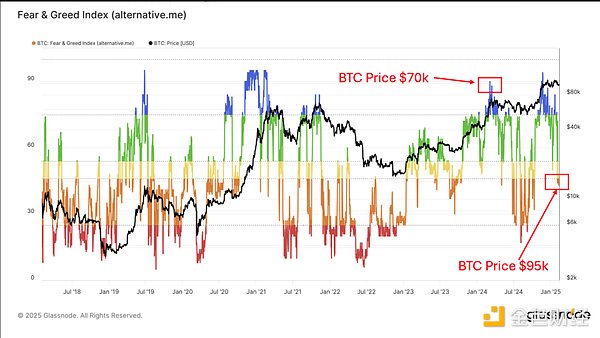
The data below shows the trend of the funding rate - this indicator measures the holding fee paid by longs to shorts every 8 hours. This data provides us with an important window into traders' willingness to use leverage, and is an excellent indicator of market sentiment and momentum.
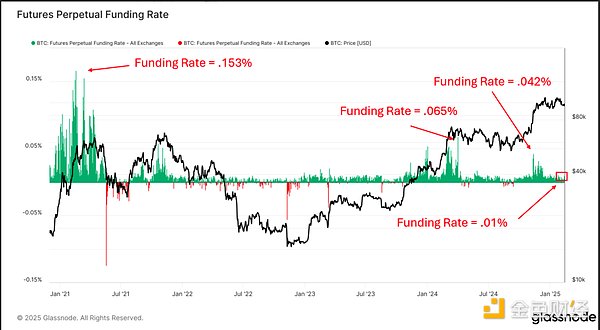
The data shows that the trend of the fear/greed index is mutually confirmed. So why are investors so panicked?
The main reason is that market funds are mainly concentrated in altcoins and meme coins - these currencies have fallen by 50-75% as the Bitcoin Dominance Index has returned to above 60%. At the low point of the market, investors began to question whether there can still be a real "altcoin season".

*The above data looks at the top 200 assets by market capitalization, which have a higher 90-day return than Bitcoin.
In short, when the market is volatile, you always want to stay volatile.
We think now is the right time to consider picking up altcoins again (we will share some popular altcoins later).
2. BTC on-chain data analysis
If you plan to invest in altcoins, we think you need to have a view on the direction of Bitcoin. That's why we focus on Bitcoin in our on-chain data updates.
In this section, we will introduce some of our favorite "cycle" indicators and share where we are today relative to the peaks of past cycles.
●MVRV - Long-term holders
MVRV (market value to realized value ratio) helps us understand the relationship between the current market value and the "cost basis" (realized value) of Bitcoin in circulation.
Glassnode calculates the cost basis of all Bitcoins on the network by calculating the latest mobile price of each UTXO on the chain.
It does not take into account Bitcoin in exchanges or ETFs (about 18% of the supply).
For this analysis, we separate long-term holders (wallets that have not moved BTC in at least 155 days) from short-term holders (wallets that have moved BTC within 155 days).
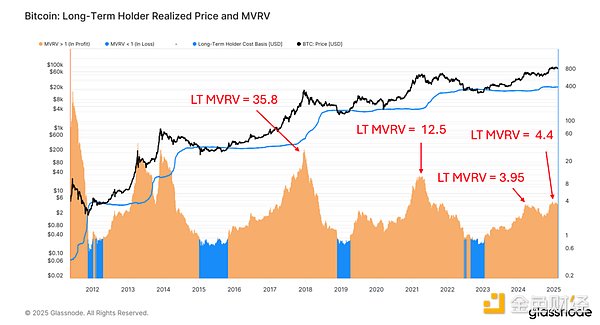
Summary: The MVRV for long-term holders reached a high of 4.4 on December 17th and is 3.96 today. This tells us that, on average, long-term holders are sitting on a 296% gain. In the last cycle, this group saw gains of 1,150%, and in the 2017 cycle, they saw gains of 34,800%.
● MVRV - Short-Term Holders
One thing to note: Short-term holders tend to chase the market. They enter the game late and tend to buy tokens from long-term holders.
Summary:
* The MVRV (market value to realized value ratio) for short-term holders is currently 1.06, meaning they are almost at the break-even point, while this ratio was as high as 1.45 in March last year.
* Looking back at the last cycle, when the market peaked, short-term holders had unrealized gains of up to 74%.
*20% of circulating supply is currently in the hands of short-term holders (compared to 16.4% last year), not including exchange or ETF holdings. It is worth noting that at the peak of the last cycle, short-term holders controlled 24% of supply (before ETFs existed). This is quite revealing, as it shows that there is more new money flowing into the market today than a year ago, and from a percentage perspective, we are getting closer to the level at the peak of the last cycle.
● Long-term holder supply
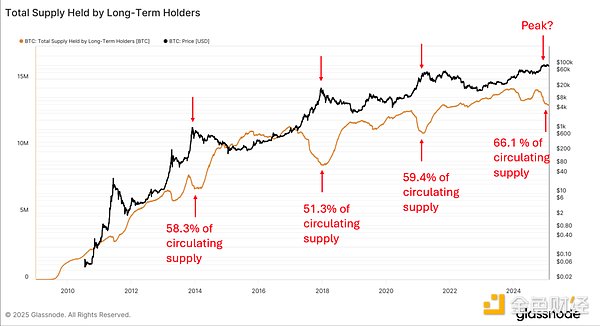
Summary:
*At the beginning of this cycle, 73.3% of the tokens in circulation were held by long-term holders. Today, this proportion has dropped to 66.1%, a decrease of 7.2%.
*Looking back at the last cycle, 67.2% of the supply was initially controlled by long-term holders. When the market peaked, this percentage fell to 59.4%, a decrease of 7.8%.
* If the trend of the previous cycle is followed, the data for both short-term and long-term holders suggest that we are currently in the late stage of the cycle.
● Amount of BTC on exchanges
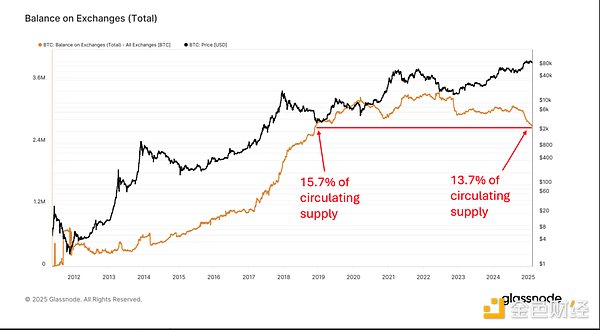
Summary:
*There are fewer Bitcoins on exchanges now than at the end of 2018, but the market is much larger today - most institutions are now able to buy Bitcoin.
*We usually see the yellow line rise at the end of the cycle as investors send their Bitcoin back to exchanges to cash out. We are not seeing any strong signs of this at the moment. ETFs may play a role in this.
● Pi Cycle Top Indicator
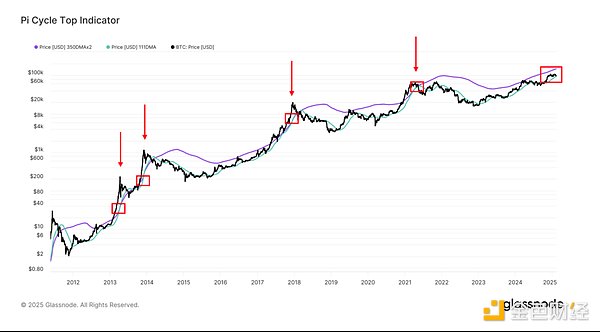
The Pi Cycle Top Indicator has historically been an accurate tool for identifying Bitcoin market peaks. It is composed of the 111-day moving average and 2 times the 350-day moving average.
When the market is overheated, the shorter 111-day moving average will cross over the longer 350-day moving average.
We can see above that there is still a healthy gap between the two moving averages - this suggests that the market has not yet reached extreme levels.
● Stablecoins
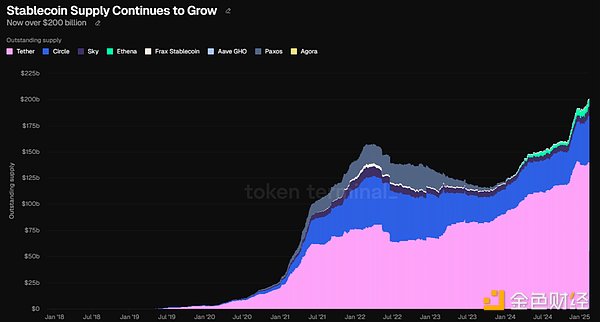
Summary:
* Tether's supply grew by over $20 billion from U.S. presidential election day to the end of the year. It has stagnated since then (zero growth in the past two months).
*USDC is now the leader (mostly on Solana). Up 22% in the last two months (over $7 billion).
*We are watching the growth of stablecoins closely as on-chain liquidity correlates to crypto prices. A new stablecoin bill (which would likely be the first legislation we see) could radically change the dynamics of this chart.
● ETF
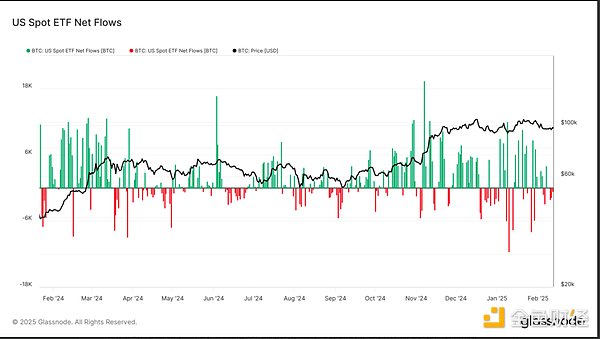
Summary:
* Bitcoin net flows were actually negative over the past two weeks, suggesting that investors are taking profits. Despite this, ETFs saw an increase of more than $3.6 billion in net flows last month. For those who are curious, ETH ETFs have added $735 million over the past month, outperforming BTC over the past two weeks.
* Bitcoin ETFs have been trading for more than a year and have accumulated nearly $38 billion in net flows. Together, they hold more than $114 billion in AUM.
* Bitwise's ETF experts will tell you that we are more likely to see more inflows into ETFs this year than last. Why? ETFs tend to have a pattern where flows grow in year 2, year 3, and so on as liquidity generates more liquidity. In addition, there are still large institutions that have not yet received the green light to start allocating Bitcoin.
3. New buyers in the market
In addition to on-chain data, we have to mention the emergence of several large new buyers in the market. For example:
* Abu Dhabi sovereign wealth fund Mubadala, which manages more than $1 trillion in assets, recently announced a $436 million investment in Bitcoin.
*According to Matthew Sigel of VanEck, there are currently 20 state-level Bitcoin reserve bills. If passed, these bills could drive $23 billion in purchases.
*The repeal of SAB121 means banks can now custody crypto assets.
*New FASB rules state that companies can now hold Bitcoin on their books at fair value, marking the value of their holdings as unrealized gains for the first time. Previously, Bitcoin was recorded as an intangible asset and only took impairments.
And we haven’t even mentioned strategic Bitcoin reserves yet. A newly formed committee plans to make a decision by July. We think other central banks may already be jumping on the action.
The conclusion? Bitcoin is now mature. It has always traded like a risk-on asset driven by retail FOMO. That is changing. Investors should expect that if central banks start holding this asset, it could transform into a “safe haven” asset with less volatility over time. We believe we are already seeing this effect, with ETF buyers bringing more stable demand.
4. Final Thoughts and Portfolio Management
Combining our past and current analysis, our conclusion is that Bitcoin (and the entire crypto market) has some room to run. But this does not mean there are no risks. Some on-chain indicators suggest caution is needed. Not to mention, we have seen a lot of “top” behavior in this cycle. At the same time, from a macro and on-chain data perspective, it is difficult for us to align with the bearish view. Don’t forget that the biggest fluctuations in the crypto market often occur at the end of the cycle.
As for portfolio management? In this current cycle, we like to adopt a barbell strategy. This means that we hold core assets such as BTC, ETH, SOL, and other projects with strong fundamentals (cash flow and buybacks). These include HYPE and Raydium. We also like TIA and SUI as other L1 options. This is one end of the barbell (which we think should be more skewed toward BTC/ETH/SOL). We then pair these core assets with a small allocation to blue-chip meme coins with high beta and ample liquidity. SPX6900, GIGA, PEPE, and BONK are our favorites - all of which are down over 50% from their highs as of this writing.
 Anais
Anais













